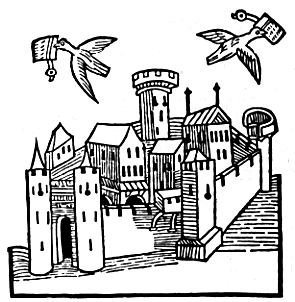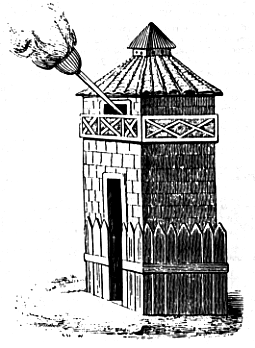 776 BC: Homing
pidgeons used to announce the outcome of the Olympic Games to the Athenians.
776 BC: Homing
pidgeons used to announce the outcome of the Olympic Games to the Athenians.Try an experiment: the party game of telephone
Sending a message reliably is not as easy it seems.
Thought experiment #1: how to send a message via smoke signals
Thought experiment #2: how to send a message via runners
A very simple transposition code:
A B C D E F G H I J K L M N O P Q R S T U V W X Y Z
B C D E F G H I J K L M N O P Q R S T U V W X Y Z A
this is a secret message
uijt jt b tfdsfu nfttbhf
Key elements of building a communications systems:
490 BC: Phidippides runs from Marathon to Athens (36.2 km, 22.5 miles) to warn the Athenians of an approaching Persian army (he supposedly died from the strain!).
Human messagers on foot or horseback in Egypt (Second Millennium BC) or China (First Millennium BC). Relay stations on major roads.
approx. 650 BC: Babylonian kings place guard stations along major roads. Messages travel by relay courier from one station to the next. Fire beacons introduced to permit signaling from one station to the next without the need for human runners.
"We have observed still another device of Cyrus' (King of Persia, circa 530 BC) for coping with the magnitude of his empire; by means of this institution he would speedily discover the condition of affairs, no matter how far distant they might be from him: he experimented to find out how great a distance a horse could cover in a day when ridden hard, but not so hard as to break down, and then he erected post-stations at just such distances and equipped them with horses, and men to take care of them; at each one of the stations he had the proper official appointed to receive the horses and riders and send on fresh ones. They say, moreover, that sometimes this express does not stop all night, but the night-messengers succeed the day messengers in relays, and when this is the case, this express, some say, gets over ground faster than the cranes." Xenophon (430-355 BC) in Cyropaedia.
14 AD: Roman relay system
1280 AD: Kublai Khan
"Let us turn now to the system of post-horses by which the Great Khan sends his dispatches. You must know that the city of Khan-balik is a centre from which many roads radiate to many provinces, one to each, and every road bears the name of the province to which it runs. The whole system is admirably contrived. When one of the Khan's messengers sets out along any of these roads, he has only to go 25 miles and there he finds a posting station. Here the messengers find no less than 400 horses, stationed here by the Great Khan's orders and always kept in readiness for his messengers when they are sent on any mission. And you must understand that posts such as these, at distances of 25 or 30 miles, are to be found along all of the main highways leading to the provinces. The whole organization is so stupendous and so costly that it baffles speech and writing." Marco Polo
1861 AD: US Pony Express.
 776 BC: Homing
pidgeons used to announce the outcome of the Olympic Games to the Athenians.
776 BC: Homing
pidgeons used to announce the outcome of the Olympic Games to the Athenians.
1918 AD: British Air Force used over 20,000 homing pidgeons during WW I
1981 AD: Pidgeons used to transmit negatives of drawings from Sunnyvale to a test station 40 km (25 mi) away.
"The pidgeon took just half the time and less than 1% of the dollar amount of the car. Over a 16-month period the pidgeons transmitted hundreds of rolls of film and lost only two." Jon Bentley
How do you transmit messages faster than is possible with (human, horse, or bird) muscle power?
Using mirrors to signal messages: helio = sun, graph = to write, that is, write with the sun.
37 AD: Used by the Roman Emperor Tiberius
"For nearly ten years during the reign of the wise but unpopular emperor Tiberius, Rome was ruled from the island of Capri. Each day he sent orders to the mainland by a type of "heliograph" which transmitted the sun's rays by means of a mirror of polished metal."
There is some dispute about whether Tiberius used mirrors or some form of signal torches.
"Prof. Gauss ... invented a device to direct a controlled beam of sunlight to a distant station. It included "silvered and unsilvered mirrors" fixed at right angles to each other. The operator looked in the unsilvered mirror at the distant station. Then he turned both mirror's so the sun's image (reflected faintly from the plain surface of the unsilvered mirror) was superimposed over the distant station, automatically directing the beam from the silvered mirror in the same direction."

This device was extensively used by the British and American armies as a "wireless" field telegraph. In 1869, Henry Mance added movable mirror so device could be used to signal Morse code. Used extensively in British India up to 1890.
Used by U.S. General Miles in battles with Native Americans in Arizona in the late 1880s. Set up 27 signaling stations, 40-50 km apart. Averaged about 16 words per minute.
1851 AD: Charles Babbage invents a light-flashing machine, the "occulting telegraph:"
"I then, by means of a small clock-work and an argand lamp, made a numerical system of occultation, by which any number might be transmitted to all those within sight of a source of light."
What happens if the day is overcast? Or if the sun is behind your back?
Signaling with coded flags
Early references in Plutarch (46-120 AD) about Greek naval battles circa 410 BC.
900 AD: Byzantine Navy:
"During naval operations, the captains of the ships were expected to observe the "pamphylus" of the admiral, who gave orders by signaling from different sides and heights of the central flagship with banners of various colors, or with firs and smoke. A whole code of signals existed with which the commanders and their crews had to be acquainted."
1738 AD: de la Bourdonnais introduces numerical code for flags. 10 colored flags indicating the numerials 0-9. 3 sets of flag yield 1000 different signals.
Question: to represent the 26 letters of the alphabet and the ten numerials, what is the minimum number of flags you would need using a system along the lines of de la Bourdonnais?
1763 AD: de Bigot, founder of the French Marine Academy in Brest.
Cannons, flares, lights for transmitting coded messages during night or fog.
 1790 AD: Lord
Richard Howe, British Royal Navy, The Howe Code
1790 AD: Lord
Richard Howe, British Royal Navy, The Howe Code
1803 AD: Admiral Sir Home Popham, British Royal Navy, "Telegraphic Signals of Marine Vocabulary," known as the Popham Code, and later as the .
# |
Word |
# |
Word |
# |
Phrase |
|---|---|---|---|---|---|
| 26 | Able | 1026 | Aback | 2026 | Shall I leave off action? |
| 27 | Above | 1027 | Abate-d-ing-ment | 2027 | I have been in action |
| 28 | About | 1028 | Abrupt-ly | 2028 | I have not seen any action |
| 29 | Abreast | 1029 | Abundance-t-ly | 2029 | I have heard of an action |
| 30 | Absence-t-ed-ing-tee | 1030 | Accomodate-d-ing | 2030 | |
| 31 | Absolutely | 1031 | Accomplish-ed-ing-ment | 2031 | I am clear for action |
| 32 | Accept-ed-ing-ance | 1032 | Account-ed-ing | 2032 | Shall I commence action? |
| 33 | Accidently | 1033 | Accurate-ly | 2033 | |
| 34 | Accompany-i-ed | 1034 | Accuse-d | 2034 | In coming into action, do you lead? |
| 35 | According-ly | 1035 | Acknowledge-d-ing-ment | 2035 | Go to the Admiral's office |
1805 AD: The Battle of Trafalgar, Admiral Horatio Nelson
"England expects every man will do his duty": seven words are in the code book (single hoist of 3 flags), "duty" must be spelled out with single and double flag hoists
 Wig Wag
Wig Wag1860 AD: Albert James Myer, US Army Doctor: signaling scheme with flags or torches based on two basic motions: move to the left or right.
 1184 BC: Siege
of Troy: systematic description of fire signals to transmit messages (Homer,
Aeschylus, Vergil).
1184 BC: Siege
of Troy: systematic description of fire signals to transmit messages (Homer,
Aeschylus, Vergil).
500-400 BC: Herodotus, Thucydides describe use of beacon signals by the Greeks and Persians.
113 AD: Emperor Trajan: torch signaling stations.
No descriptions of permanent installations, two-way communications, or a system of encoding messages.
315 BC: Persia: first recorded use of stentors, that is, shouters, who passed messages between calling posts. Used for short, high priority messages. Fire signals used at night. Other messages by mounted couriers.
52 BC: Julius Caesar: via load calls across fields and plains, a message could be sent 150 miles between sunrise and sunset.
150 BC: Polybius Histories.
"Now in former times, as fire signals were simple beacons, they were for the most part of little use to those who used them. ... it is chiefly unexpected occurences which require instant consideration and help -- all such matters defied communications by [prearranged] fire signal."
 Describes Aeneas' scheme for signaling
messages (350 BC) using a pre-calibrated water vessel to synchronize sender
and receivers. Raising a torch when the unstoppered vessel reaches a particular
level indicates a particular prearranged message.
Describes Aeneas' scheme for signaling
messages (350 BC) using a pre-calibrated water vessel to synchronize sender
and receivers. Raising a torch when the unstoppered vessel reaches a particular
level indicates a particular prearranged message.
Still requires prearrangement of message meanings. This is the first recorded description of the need for a method to encode the alphabet into signals in order to transmit arbitrary messages.
![]() Scheme he used: 5 groups of 5 letters
(Greek has 24 letters), encoded by 10 torches. First set of five indicate
which group (raised on the left), then second set of five indicate letter
within group (raised on the right).
Scheme he used: 5 groups of 5 letters
(Greek has 24 letters), encoded by 10 torches. First set of five indicate
which group (raised on the left), then second set of five indicate letter
within group (raised on the right).
Initial synchronization by raising and lower two torches. Out of band signaling by raising torches from both right and left at the same time. Viewing tubes to focus the field of view.
Modern reconstructions have been able to achieve eight letters per minute.
Not much progress over the next 2000 years! However, the development of the telescope in the 16th Century made it possible to separate the signaling stations by a greater distance. Clocks improved the synchronization of the communications.
Method |
First Recorded Use |
Last Recorded Use | ||
|---|---|---|---|---|
| Pidgeons | Egypt | 2900 BC | California | AD 1981 |
| Runner/Couriers | Egypt | 1928 BC | Pony Express | AD 1860 |
| Beacons/Torches | Troy | 1184 BC | England | AD 1588 |
| Calling Posts | Persia | 400 BC | Germany | AD 1796 |
| Heliographs | Greece | 400 BC | Arizona | AD 1886 |
| Flags | Greece | 400 BC | Maritime Use | today |